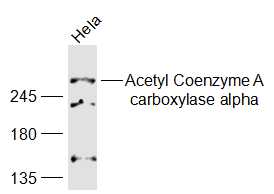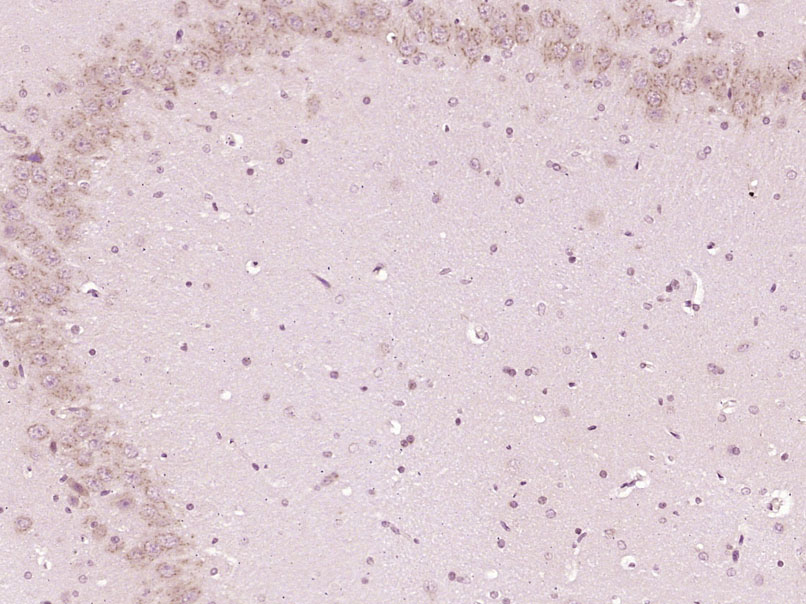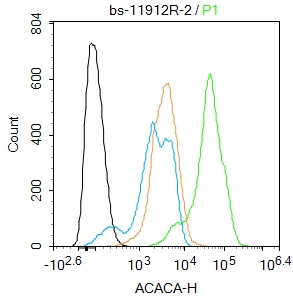
Rabbit Anti-ACACA antibody
ACACA_HUMAN; Acetyl-CoA carboxylase 1; ACC1; Acetyl-Coenzyme A carboxylase alpha; ACC-alpha; ACAC; ACC1; ACCA;
View History [Clear]
Details
Product Name ACACA Chinese Name 乙酰辅酶A羧化酶1/ACCα抗体 Alias ACACA_HUMAN; Acetyl-CoA carboxylase 1; ACC1; Acetyl-Coenzyme A carboxylase alpha; ACC-alpha; ACAC; ACC1; ACCA; literatures Research Area Tumour Cell biology Signal transduction transcriptional regulatory factor Kinases and Phosphatases The new supersedes the old Immunogen Species Rabbit Clonality Polyclonal React Species Human, Rat, (predicted: Mouse, Dog, Pig, Cow, Horse, Rabbit, Sheep, ) Applications WB=1:500-2000 IHC-P=1:100-500 IHC-F=1:100-500 IF=1:100-500 (Paraffin sections need antigen repair)
not yet tested in other applications.
optimal dilutions/concentrations should be determined by the end user.Theoretical molecular weight 266kDa Cellular localization cytoplasmic Form Liquid Concentration 1mg/ml immunogen KLH conjugated synthetic peptide derived from human ACACA: 951-1050/2346 Lsotype IgG Purification affinity purified by Protein A Buffer Solution 0.01M TBS(pH7.4) with 1% BSA, 0.03% Proclin300 and 50% Glycerol. Storage Shipped at 4℃. Store at -20 °C for one year. Avoid repeated freeze/thaw cycles. Attention This product as supplied is intended for research use only, not for use in human, therapeutic or diagnostic applications. PubMed PubMed Product Detail Acetyl-CoA carboxylase (ACC) is a complex multifunctional enzyme system. ACC is a biotin-containing enzyme which catalyzes the carboxylation of acetyl-CoA to malonyl-CoA, the rate-limiting step in fatty acid synthesis. There are two ACC forms, alpha and beta, encoded by two different genes. ACC-alpha is highly enriched in lipogenic tissues. The enzyme is under long term control at the transcriptional and translational levels and under short term regulation by the phosphorylation/dephosphorylation of targeted serine residues and by allosteric transformation by citrate or palmitoyl-CoA. Multiple alternatively spliced transcript variants divergent in the 5' sequence and encoding distinct isoforms have been found for this gene. [provided by RefSeq, Jul 2008]
Function:
Catalyzes the rate-limiting reaction in the biogenesis of long-chain fatty acids. Carries out three functions: biotin carboxyl carrier protein, biotin carboxylase and carboxyltransferase.
Subunit:
Monomer, homodimer, and homotetramer. Can form filamentous polymers. Interacts in its inactive phosphorylated form with the BRCT domains of BRCA1 which prevents ACACA dephosphorylation and inhibits lipid synthesis. Interacts with MID1IP1; interaction with MID1IP1 promotes oligomerization and increases its activity.
Subcellular Location:
Cytoplasm.
Tissue Specificity:
Expressed in brain, placental, skeletal muscle, renal, pancreatic and adipose tissues; expressed at low level in pulmonary tissue; not detected in the liver.
Post-translational modifications:
Phosphorylation on Ser-1263 is required for interaction with BRCA1.
DISEASE:
Defects in ACACA are a cause of acetyl-CoA carboxylase 1 deficiency (ACACAD) [MIM:200350]; also known as ACAC deficiency or ACC deficiency. An inborn error of de novo fatty acid synthesis associated with severe brain damage, persistent myopathy and poor growth.
Similarity:
Contains 1 ATP-grasp domain.
Contains 1 biotin carboxylation domain.
Contains 1 biotinyl-binding domain.
Contains 1 carboxyltransferase domain.
SWISS:
Q13085
Gene ID:
32
Database links:Entrez Gene: 32 Human
Entrez Gene: 107476 Mouse
SwissProt: Q13085 Human
SwissProt: Q5SWU9 Mouse
Product Picture
Hela(Human) Cell Lysate at 30 ug
Primary: Anti-Acetyl Coenzyme A carboxylase alpha (SL11912R) at 1/1000 dilution
Secondary: IRDye800CW Goat Anti-Rabbit IgG at 1/20000 dilution
Predicted band size: 266 kD
Observed band size: 266 kD
Paraformaldehyde-fixed, paraffin embedded (Rat brain); Antigen retrieval by boiling in sodium citrate buffer (pH6.0) for 15min; Block endogenous peroxidase by 3% hydrogen peroxide for 20 minutes; Blocking buffer (normal goat serum) at 37°C for 30min; Antibody incubation with (Acetyl Coenzyme A carboxylase alpha) Polyclonal Antibody, Unconjugated (SL11912R) at 1:400 overnight at 4°C, followed by operating according to SP Kit(Rabbit) (sp-0023) instructionsand DAB staining.Blank control(black line):HepG2.
Primary Antibody (green line): Rabbit Anti-ACACA antibody (SL11912R)
Dilution:2ug/Test;
Secondary Antibody(white blue line): Goat anti-rabbit IgG-AF488
Dilution: 0.5ug/Test.
Isotype control(orange line): Normal Rabbit IgG
Protocol
The cells were fixed with 4% PFA (10min at room temperature)and then permeabilized with 90% ice-cold methanol for 20 min at -20℃, The cells were then incubated in 5%BSA to block non-specific protein-protein interactions for 30 min at room temperature .Cells stained with Primary Antibody for 30 min at room temperature. The secondary antibody used for 40 min at room temperature. Acquisition of 20,000 events was performed.
Partial purchase records(bought amounts latest0)
No one bought this product
User Comment(Total0User Comment Num)
- No comment





 +86 571 56623320
+86 571 56623320




